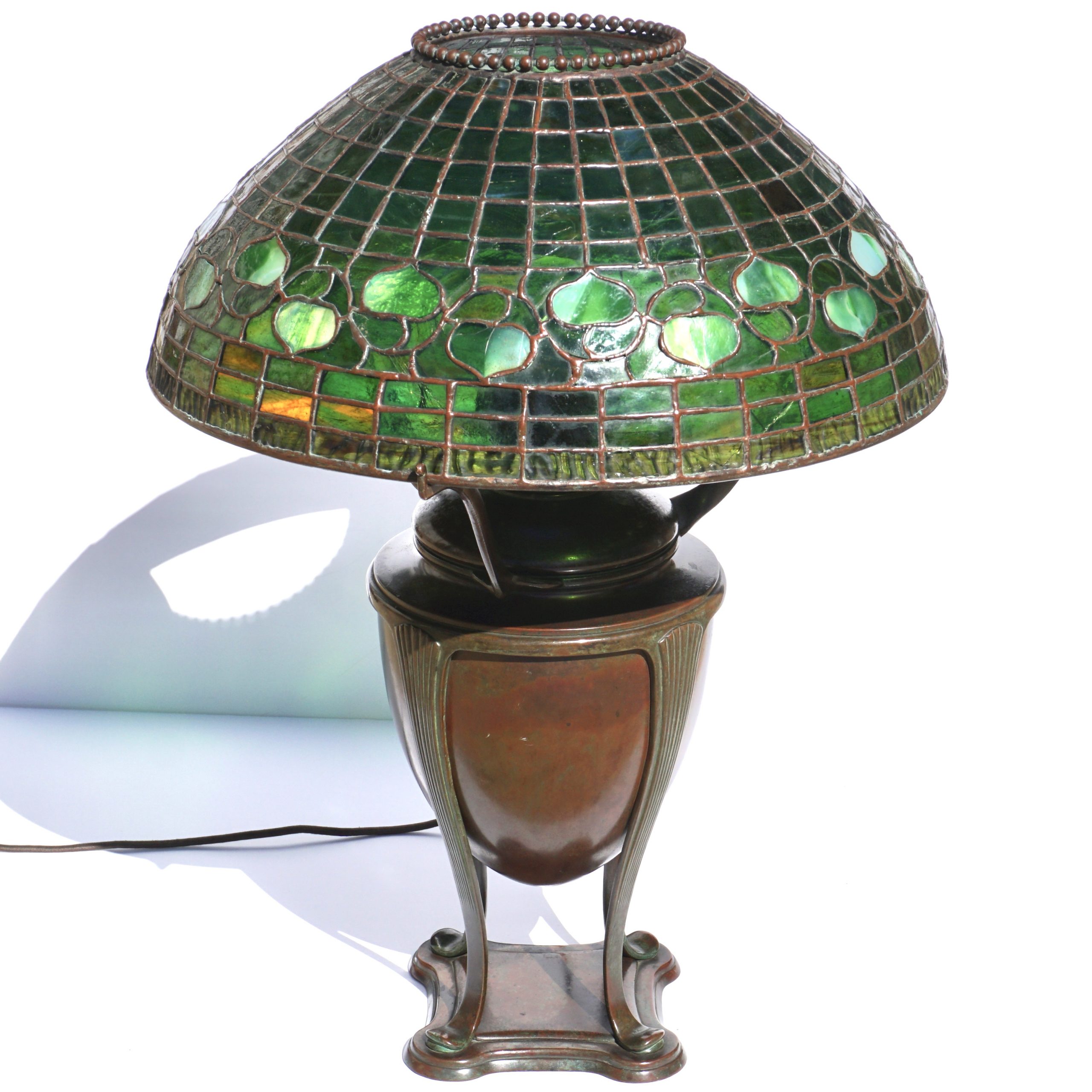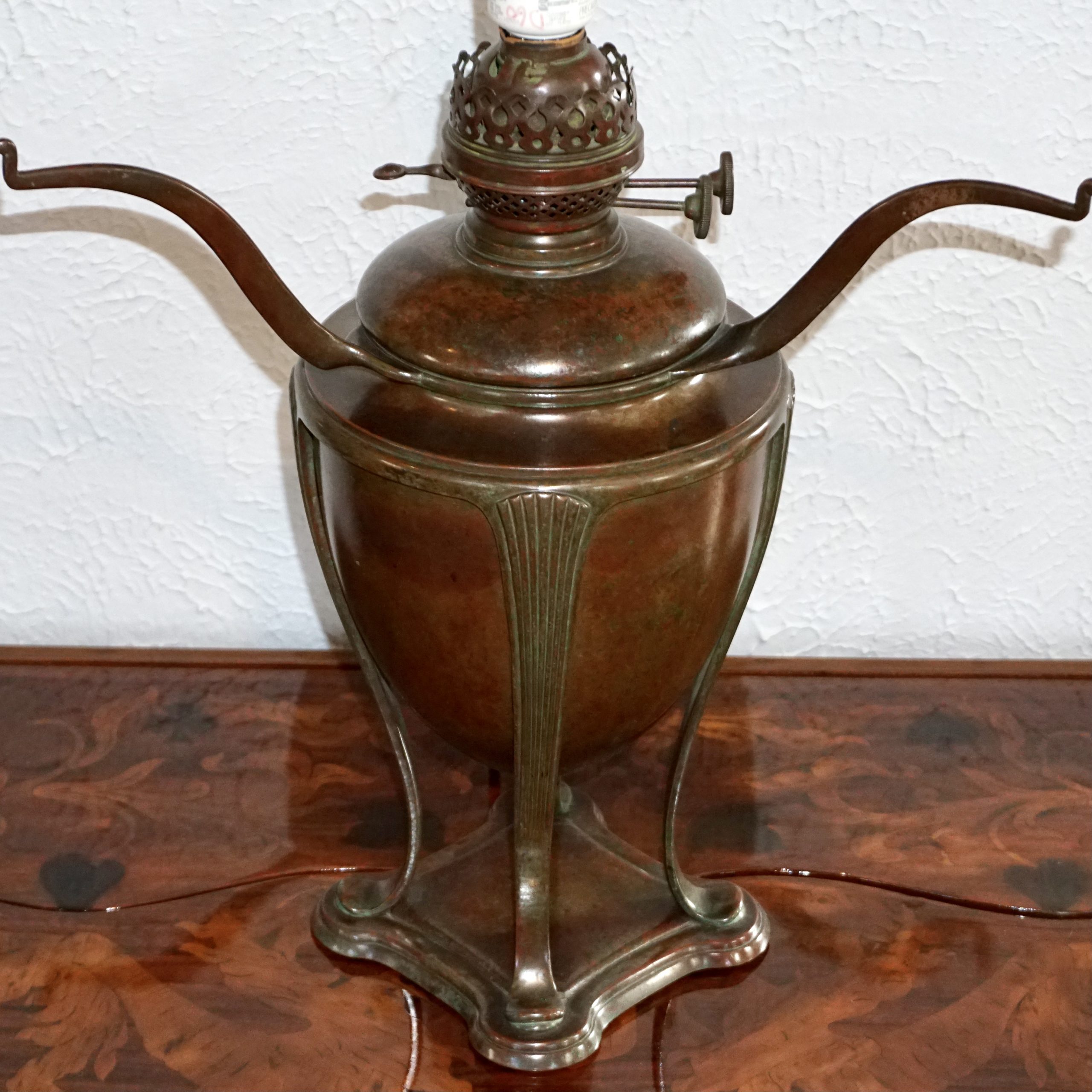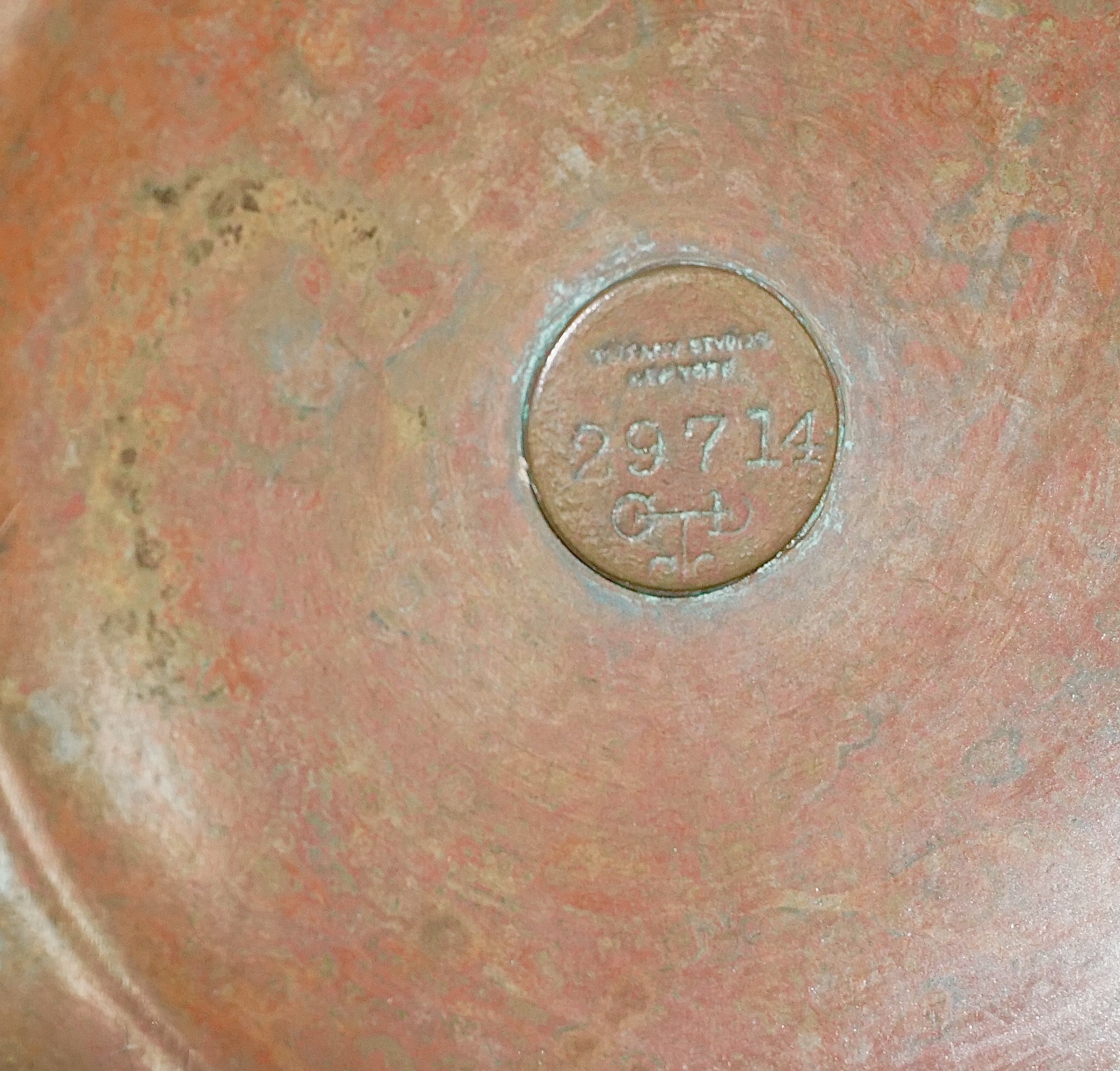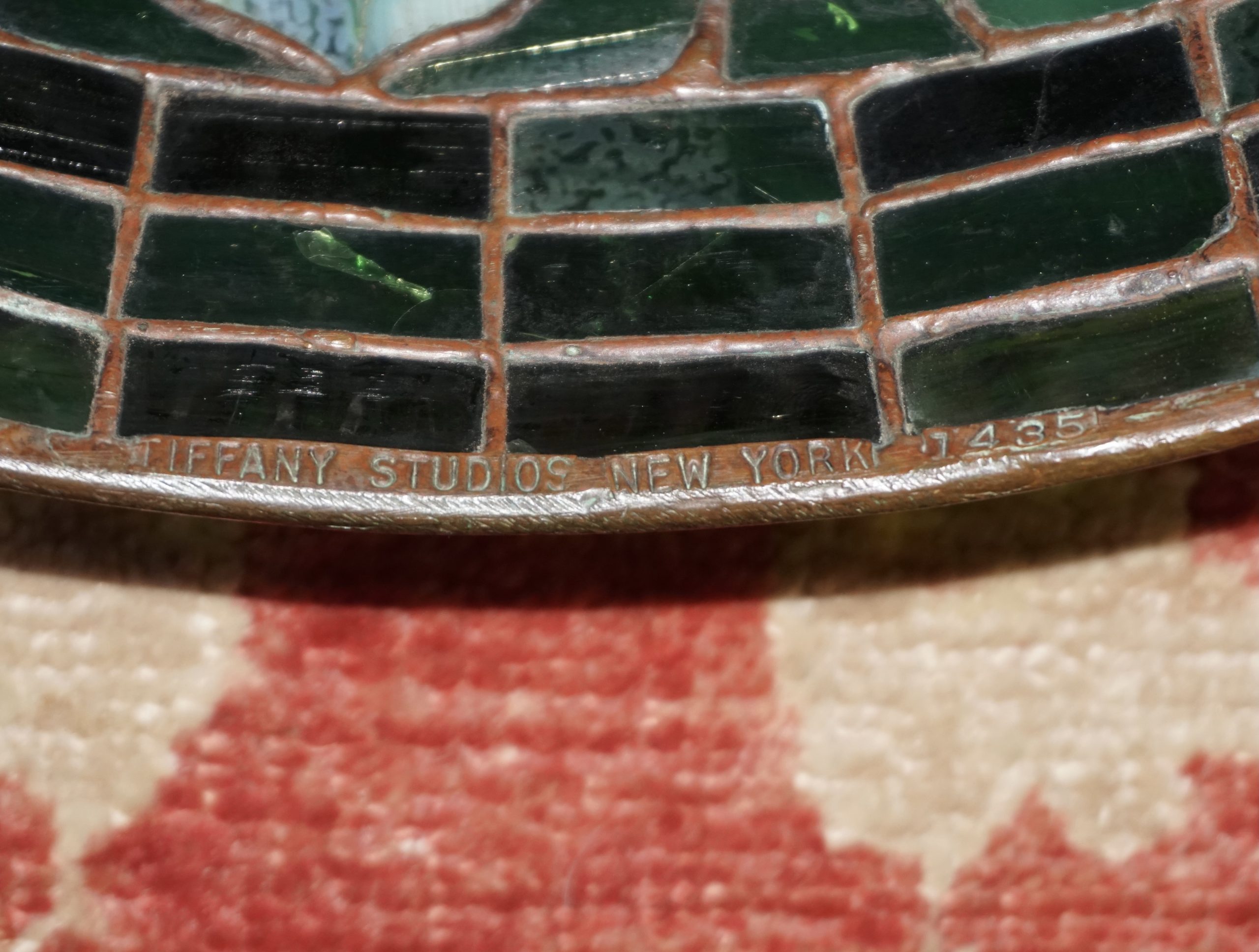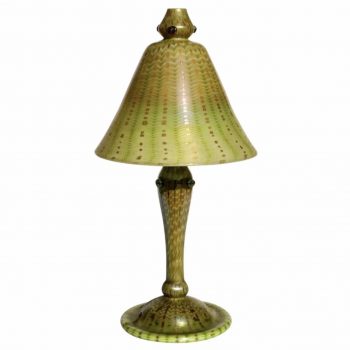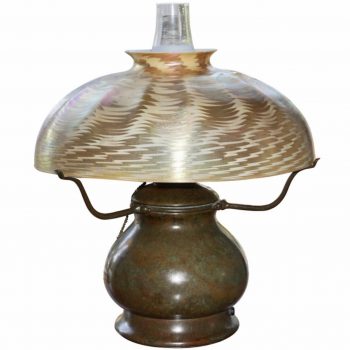Description
A Tiffany Studios Acorn leaded Glass And Bronze Table Lamp. Circa 1895.
This lamp is an early example. Circa the 1890s; Tiffany was developing what would become the common table lamp. With the onset of electricity and the demise of oil lamps came these creative and elaborate stained glass lamps to supply the wealthy large homes being built with electricity at the turn of the last century. The 16 Inch diameter green acorn stained glass shade is made with lead and patinaed bronze to match the beautiful bronze bases that marry these table lamps together. This particular shade is rare with Tiffany’s Linenfold glass on the bottom border and beaded bronze work on the top rim. In Tiffany Studios stores circa 1900; clients chose the combination of shades available at the time to a base of their choosing.
The Tiffany Studios bronze acorn base base that accompanies this shade has the signature beautiful red, green and brown gorgeous patina synonymous of Tiffany’s greatest works. Originally an oil lamp; this base was electrified by Tiffany to keep up with the times. A rare and wonderful piece of history.
Shade signed “TIFFANY STUDIOS NEW YORK 1335”
Base canister signed “TIFFANY STUDIOS NEW YORK 29714” with monogram
Condition: Very good. Approximately 15 scattered heat cracked panels. Shade sits very flat and is not warped. Base with wonderful original patina with wear commensurate of age and use with no noticeable dents. Spider arms are slightly bent. New wiring with original socket.
AVANTIQUES is dedicated to providing an exclusive curated collection of Fine Arts, Paintings, Bronzes, Asian treasures, Art Glass and Antiques. Our inventory represents time-tested investment quality items with everlasting decorative beauty. We look forward to your business and appreciate any reasonable offers. All of our curated items are vetted and guaranteed authentic and as described. Avantiques only deals in original antiques and never reproductions. We stand behind our treasures with a full money back return policy if the items are not as described.
Tiffany Studios Although Louis Comfort Tiffany’s company is best known by the name of Tiffany Studios, his vast creative enterprise operated under various names through the years. These include Louis C. Tiffany & Company (1878–85); Tiffany Glass Company (1885–92); Tiffany Glass and Decorating Company (1892–1900); Allied Arts (1900–1902); and Tiffany Studios (1902–32). Additional production support was provided by Stourbridge Glass Company (1893–1902); Tiffany Furnaces, Inc. (1902–20); and Louis C. Tiffany Furnaces, Inc. (1920–28). These too were Tiffany companies. Tiffany was the president and art director, the primary figure driving all production— artistically and technically.
Tiffany, of course, was the son of Charles Lewis Tiffany (1812–1902), founder of the successful and influential jewelry firm, Tiffany & Co. Louis Tiffany advanced his reputation by his own name and his father’s. Tiffany once reportedly stated: “Go after the money there is in art, but the art will be there just the same.” These words are the sentiment of an artist who created a marketing machine, but who in the end allowed the artistic side to rule. Louis Tiffany’s financial backers, mainly his father, were called upon time and again to keep his companies solvent. His familial ties facilitated prominence at international expositions—a decided advantage for a young artist with big ambitions. His firms always exhibited aside Tiffany & Co. Louis Tiffany, therefore, was able to enhance the marketability of his own wares by capitalizing on the Tiffany name established by his father.
Louis Tiffany’s studio system was not a simple enterprise; he needed specialized workers to accomplish his goals. Under Tiffany’s watch, teams of talented designers and craftspeople translated his all-encompassing vision into the beautiful objects—blown-glass vases, leaded-glass windows and lamps, pottery, jewelry, and more—that captivated an era. He publicly credited a number of these individuals for their work. In the Synopsis of the Exhibit of the Tiffany Glass and Decorating Company from the World’s Columbian Exposition in 1893, for example—published by Tiffany Glass and Decorating Company and freely distributed—Will H. Low (1853–1932) and Lydia Emmet (1866–1952) are cited beneath pictures of their designs. Other important designers at Tiffany’s company included Frederick Wilson (1858–1932), Joseph Lauber (1855–1948), Edward P. Sperry (d. 1925), Agnes Fairchild Northrop (1857–1953), Alice Carmen Gouvy (1863–1924), and Clara Driscoll (1861–1944). Neither Tiffany Studios nor the Tiffany companies preceding it were created to function as guilds where individual artists are equally recognized. They were designed in the historic tradition of studios that produced works under the name of an established artist. Providing a portrait of Tiffany’s career, including his companies, is complicated. Scholars rely on surviving business records and personal accounts of individual employees to glean facts and insights.
The discovery in the early 2000s of a trove of letters written by Clara Driscoll, a talented designer who supervised the Women’s Glass Cutting Department for Tiffany, has provided invaluable new information about aspects of production at Tiffany Studios. Still, one employee cannot tell the whole story. Tiffany created his studios under a specific design theory—one based on his own ideals but under which he encouraged designers to interpret creatively. In addition to his supervision, evidenced in signatures on designs and personal accounts of his visits out to the glasshouse in Corona, New York, he maintained a design file to provide inspiration for the designers. The files included photographs of works created early in his career, of historic monuments of personal interest to Tiffany, and of sights and objects from his travels. With these measures in place, Tiffany secured the unity and quality of overall production of his companies.
Please also consider Avantiques eclectic Art Glass and Pate De Verre collection including Emile Galle, Daum Nancy, Schneider, Argy Rousseau, Almeric Walter, D’Argental, St Louis, Decorchemont, and Louis Comfort Tiffany Studios. We strive to collect the highest quality glass pieces in exceptional condition.




